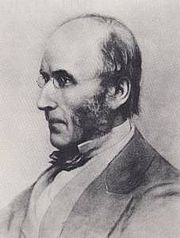William Butterfield
William Butterfield (born September 17, 1814 in London , † February 23, 1900 there ) was an English architect . His buildings are to be assigned to the neo-Gothic style ("Gothic Revival"), with churches and rectories being the focus of his work. Butterfield was closely associated with the Oxford Movement, which was important in the Anglican Church in the 19th century .
Butterfield came from a family of nonconformists who ran a drug store in London, Strand . He was one of nine children and when he finished school, at 16, began an apprenticeship with the master builder Thomas Arber in the Pimlico district of London . In the years 1833-36 Butterfield studied architecture at EL Blackburne and was then (1838-1839) assistant to the Worcester- based architect Harvey Eginton, with whom he completed his apprenticeship. Around 1840 he opened his own architectural office in Lincoln's Inn Fields .
In 1842 Butterfield became a member of the Cambridge Camden Society and later the Ecclesiological Society , where he was responsible for the appearance of the society's journal, the Ecclesiologist . This work in the context of the Anglican Church also influenced his architectural work. Despite his non-conformist origins, he was always a supporter of the so-called High Church and the Oxford Movement. Its architectural style belonged to the neo-Gothic circle of forms, ie it was based on old Gothic forms and revived them in the spirit of the Victorian era. He designed mainly church buildings, but also a number of colleges and schools.
In 1884 he was awarded the RIBA gold medal by the Royal Institute of British Architects for his work. In 1900 he died in London.
Buildings

- All Saints , Margaret Street, London
- Balliol College , Oxford Chapel
- Cathedral of The Isles , Great Cumbrae , Scotland
- St Savior's , Coalpit Heath
- Keble College , Oxford (1876)
- Merton College , Oxford New Buildings (1864)
- St Ninian's Cathedral , Perth , Scotland
- Rugby School Chapel and Square Courtyard (1875)
- St Alban's , Holborn
- St Augustine's College , Canterbury (1845)
- St James's , Christleton
- St. Mary Brookfield , Dartmouth Park , London (1869–75)
- Winchester County Hospital
- Horfield Parish Church
- St. James's Church , Baldersby St. James Primary School and Town Buildings, Baldersby St. James, North Yorkshire (1857)
- All Saints Babbacombe , Torquay , Devon
- Sarum College , Salisbury
- Exeter School , Exeter , Devon
- St Paul's Cathedral (excluding the steeple), Melbourne , Australia (1880-1891)
Web links
- William Butterfield (1814–1900) by Joy Heywood ( Memento June 8, 2011 in the Internet Archive ) on saintmarymagdalene.org.uk (English)
- William Butterfield in Cumbria on visitcumbria.com (English)
- Spartacus entry
- Master builder: William Butterfield by Giles Worsley In: The Telegraph 22 Mar 2003
| personal data | |
|---|---|
| SURNAME | Butterfield, William |
| BRIEF DESCRIPTION | English architect |
| DATE OF BIRTH | September 17, 1814 |
| PLACE OF BIRTH | London |
| DATE OF DEATH | February 23, 1900 |
| Place of death | London |

